Report on Change Management and Leadership Styles in Organizations
VerifiedAdded on 2023/05/28
|10
|2875
|274
Report
AI Summary
This report provides an overview of change management and its significance in today's dynamic organizational environments. It delves into various aspects of change, including the impact on employees, communication, rules, procedures, and organizational structures. The report explores how organizations manage change through effective communication, training, support, and realistic timelines. It then examines different leadership styles, such as laissez-faire, transactional, and transformational, and their applications in organizations. The analysis highlights the crucial role of leaders in driving successful change initiatives by understanding change management processes and exhibiting appropriate leadership styles. The report emphasizes the importance of employee involvement and the selection of leadership styles that align with organizational capabilities. The report also discusses the benefits of transformational leadership in facilitating change, inspiring employees, and fostering organizational commitment. The report concludes by emphasizing the need for organizations to adapt to changing environments and incorporate effective leadership models to drive innovation and competitiveness.
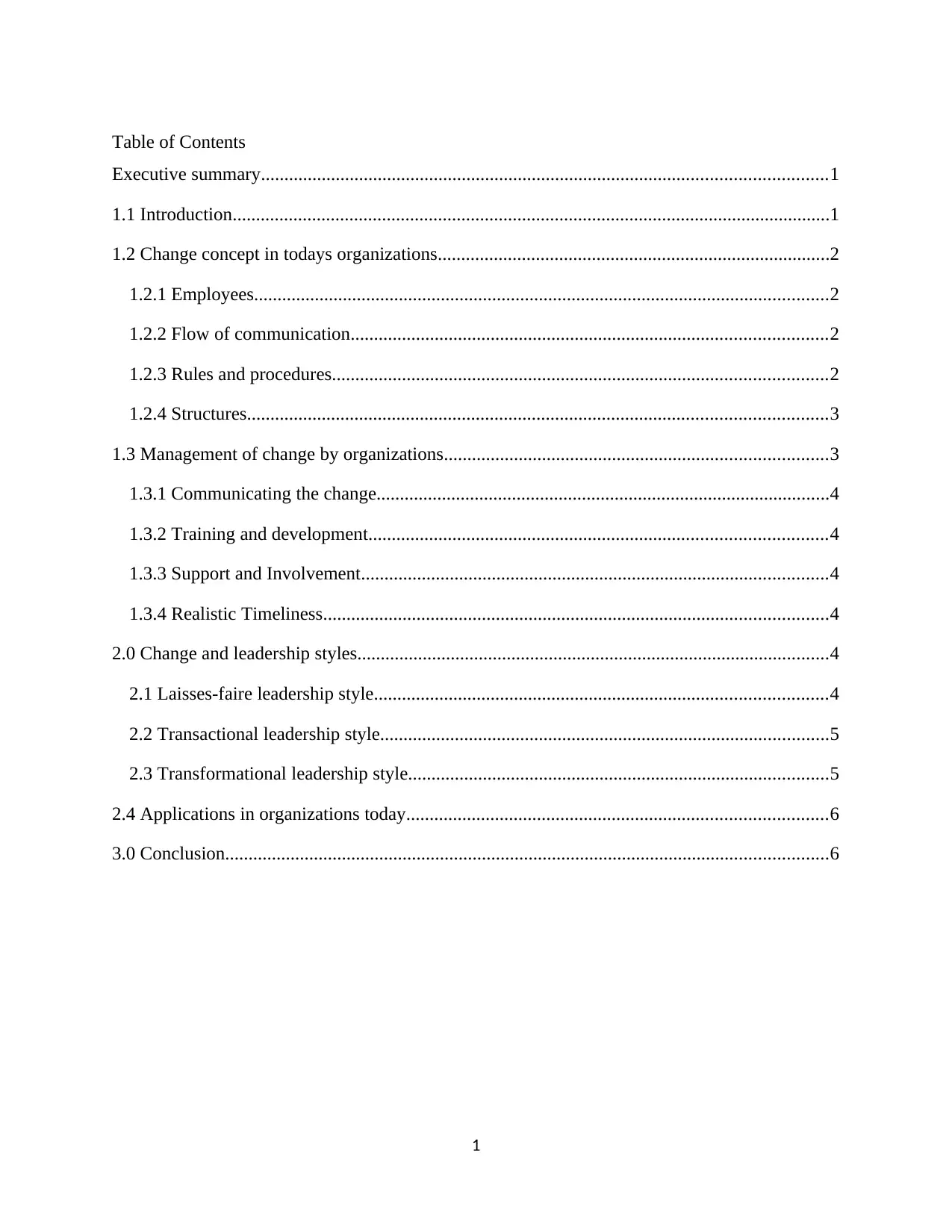
Table of Contents
Executive summary.........................................................................................................................1
1.1 Introduction................................................................................................................................1
1.2 Change concept in todays organizations....................................................................................2
1.2.1 Employees...........................................................................................................................2
1.2.2 Flow of communication......................................................................................................2
1.2.3 Rules and procedures..........................................................................................................2
1.2.4 Structures............................................................................................................................3
1.3 Management of change by organizations..................................................................................3
1.3.1 Communicating the change.................................................................................................4
1.3.2 Training and development..................................................................................................4
1.3.3 Support and Involvement....................................................................................................4
1.3.4 Realistic Timeliness............................................................................................................4
2.0 Change and leadership styles.....................................................................................................4
2.1 Laisses-faire leadership style.................................................................................................4
2.2 Transactional leadership style................................................................................................5
2.3 Transformational leadership style..........................................................................................5
2.4 Applications in organizations today..........................................................................................6
3.0 Conclusion.................................................................................................................................6
1
Executive summary.........................................................................................................................1
1.1 Introduction................................................................................................................................1
1.2 Change concept in todays organizations....................................................................................2
1.2.1 Employees...........................................................................................................................2
1.2.2 Flow of communication......................................................................................................2
1.2.3 Rules and procedures..........................................................................................................2
1.2.4 Structures............................................................................................................................3
1.3 Management of change by organizations..................................................................................3
1.3.1 Communicating the change.................................................................................................4
1.3.2 Training and development..................................................................................................4
1.3.3 Support and Involvement....................................................................................................4
1.3.4 Realistic Timeliness............................................................................................................4
2.0 Change and leadership styles.....................................................................................................4
2.1 Laisses-faire leadership style.................................................................................................4
2.2 Transactional leadership style................................................................................................5
2.3 Transformational leadership style..........................................................................................5
2.4 Applications in organizations today..........................................................................................6
3.0 Conclusion.................................................................................................................................6
1
Paraphrase This Document
Need a fresh take? Get an instant paraphrase of this document with our AI Paraphraser
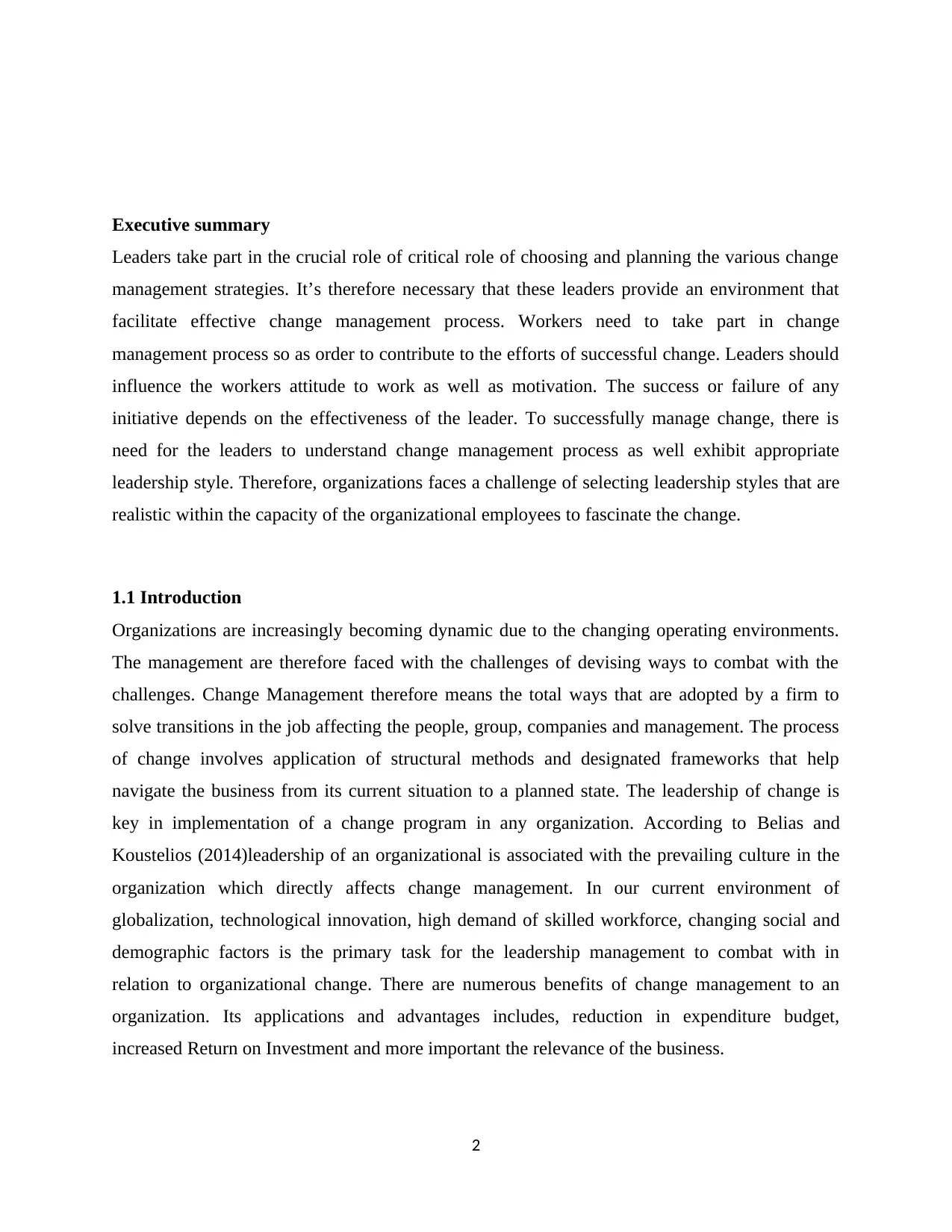
Executive summary
Leaders take part in the crucial role of critical role of choosing and planning the various change
management strategies. It’s therefore necessary that these leaders provide an environment that
facilitate effective change management process. Workers need to take part in change
management process so as order to contribute to the efforts of successful change. Leaders should
influence the workers attitude to work as well as motivation. The success or failure of any
initiative depends on the effectiveness of the leader. To successfully manage change, there is
need for the leaders to understand change management process as well exhibit appropriate
leadership style. Therefore, organizations faces a challenge of selecting leadership styles that are
realistic within the capacity of the organizational employees to fascinate the change.
1.1 Introduction
Organizations are increasingly becoming dynamic due to the changing operating environments.
The management are therefore faced with the challenges of devising ways to combat with the
challenges. Change Management therefore means the total ways that are adopted by a firm to
solve transitions in the job affecting the people, group, companies and management. The process
of change involves application of structural methods and designated frameworks that help
navigate the business from its current situation to a planned state. The leadership of change is
key in implementation of a change program in any organization. According to Belias and
Koustelios (2014)leadership of an organizational is associated with the prevailing culture in the
organization which directly affects change management. In our current environment of
globalization, technological innovation, high demand of skilled workforce, changing social and
demographic factors is the primary task for the leadership management to combat with in
relation to organizational change. There are numerous benefits of change management to an
organization. Its applications and advantages includes, reduction in expenditure budget,
increased Return on Investment and more important the relevance of the business.
2
Leaders take part in the crucial role of critical role of choosing and planning the various change
management strategies. It’s therefore necessary that these leaders provide an environment that
facilitate effective change management process. Workers need to take part in change
management process so as order to contribute to the efforts of successful change. Leaders should
influence the workers attitude to work as well as motivation. The success or failure of any
initiative depends on the effectiveness of the leader. To successfully manage change, there is
need for the leaders to understand change management process as well exhibit appropriate
leadership style. Therefore, organizations faces a challenge of selecting leadership styles that are
realistic within the capacity of the organizational employees to fascinate the change.
1.1 Introduction
Organizations are increasingly becoming dynamic due to the changing operating environments.
The management are therefore faced with the challenges of devising ways to combat with the
challenges. Change Management therefore means the total ways that are adopted by a firm to
solve transitions in the job affecting the people, group, companies and management. The process
of change involves application of structural methods and designated frameworks that help
navigate the business from its current situation to a planned state. The leadership of change is
key in implementation of a change program in any organization. According to Belias and
Koustelios (2014)leadership of an organizational is associated with the prevailing culture in the
organization which directly affects change management. In our current environment of
globalization, technological innovation, high demand of skilled workforce, changing social and
demographic factors is the primary task for the leadership management to combat with in
relation to organizational change. There are numerous benefits of change management to an
organization. Its applications and advantages includes, reduction in expenditure budget,
increased Return on Investment and more important the relevance of the business.
2
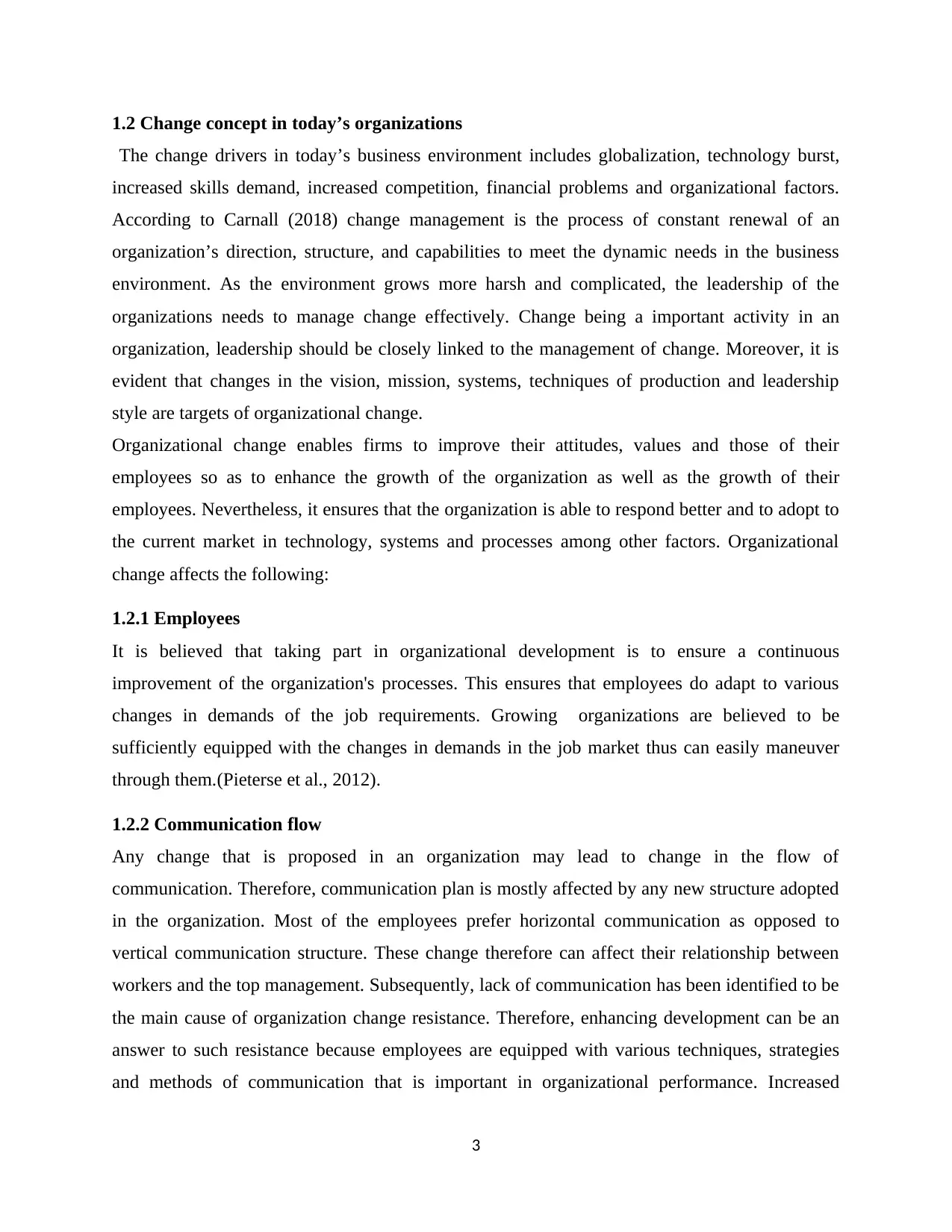
1.2 Change concept in today’s organizations
The change drivers in today’s business environment includes globalization, technology burst,
increased skills demand, increased competition, financial problems and organizational factors.
According to Carnall (2018) change management is the process of constant renewal of an
organization’s direction, structure, and capabilities to meet the dynamic needs in the business
environment. As the environment grows more harsh and complicated, the leadership of the
organizations needs to manage change effectively. Change being a important activity in an
organization, leadership should be closely linked to the management of change. Moreover, it is
evident that changes in the vision, mission, systems, techniques of production and leadership
style are targets of organizational change.
Organizational change enables firms to improve their attitudes, values and those of their
employees so as to enhance the growth of the organization as well as the growth of their
employees. Nevertheless, it ensures that the organization is able to respond better and to adopt to
the current market in technology, systems and processes among other factors. Organizational
change affects the following:
1.2.1 Employees
It is believed that taking part in organizational development is to ensure a continuous
improvement of the organization's processes. This ensures that employees do adapt to various
changes in demands of the job requirements. Growing organizations are believed to be
sufficiently equipped with the changes in demands in the job market thus can easily maneuver
through them.(Pieterse et al., 2012).
1.2.2 Communication flow
Any change that is proposed in an organization may lead to change in the flow of
communication. Therefore, communication plan is mostly affected by any new structure adopted
in the organization. Most of the employees prefer horizontal communication as opposed to
vertical communication structure. These change therefore can affect their relationship between
workers and the top management. Subsequently, lack of communication has been identified to be
the main cause of organization change resistance. Therefore, enhancing development can be an
answer to such resistance because employees are equipped with various techniques, strategies
and methods of communication that is important in organizational performance. Increased
3
The change drivers in today’s business environment includes globalization, technology burst,
increased skills demand, increased competition, financial problems and organizational factors.
According to Carnall (2018) change management is the process of constant renewal of an
organization’s direction, structure, and capabilities to meet the dynamic needs in the business
environment. As the environment grows more harsh and complicated, the leadership of the
organizations needs to manage change effectively. Change being a important activity in an
organization, leadership should be closely linked to the management of change. Moreover, it is
evident that changes in the vision, mission, systems, techniques of production and leadership
style are targets of organizational change.
Organizational change enables firms to improve their attitudes, values and those of their
employees so as to enhance the growth of the organization as well as the growth of their
employees. Nevertheless, it ensures that the organization is able to respond better and to adopt to
the current market in technology, systems and processes among other factors. Organizational
change affects the following:
1.2.1 Employees
It is believed that taking part in organizational development is to ensure a continuous
improvement of the organization's processes. This ensures that employees do adapt to various
changes in demands of the job requirements. Growing organizations are believed to be
sufficiently equipped with the changes in demands in the job market thus can easily maneuver
through them.(Pieterse et al., 2012).
1.2.2 Communication flow
Any change that is proposed in an organization may lead to change in the flow of
communication. Therefore, communication plan is mostly affected by any new structure adopted
in the organization. Most of the employees prefer horizontal communication as opposed to
vertical communication structure. These change therefore can affect their relationship between
workers and the top management. Subsequently, lack of communication has been identified to be
the main cause of organization change resistance. Therefore, enhancing development can be an
answer to such resistance because employees are equipped with various techniques, strategies
and methods of communication that is important in organizational performance. Increased
3
⊘ This is a preview!⊘
Do you want full access?
Subscribe today to unlock all pages.

Trusted by 1+ million students worldwide
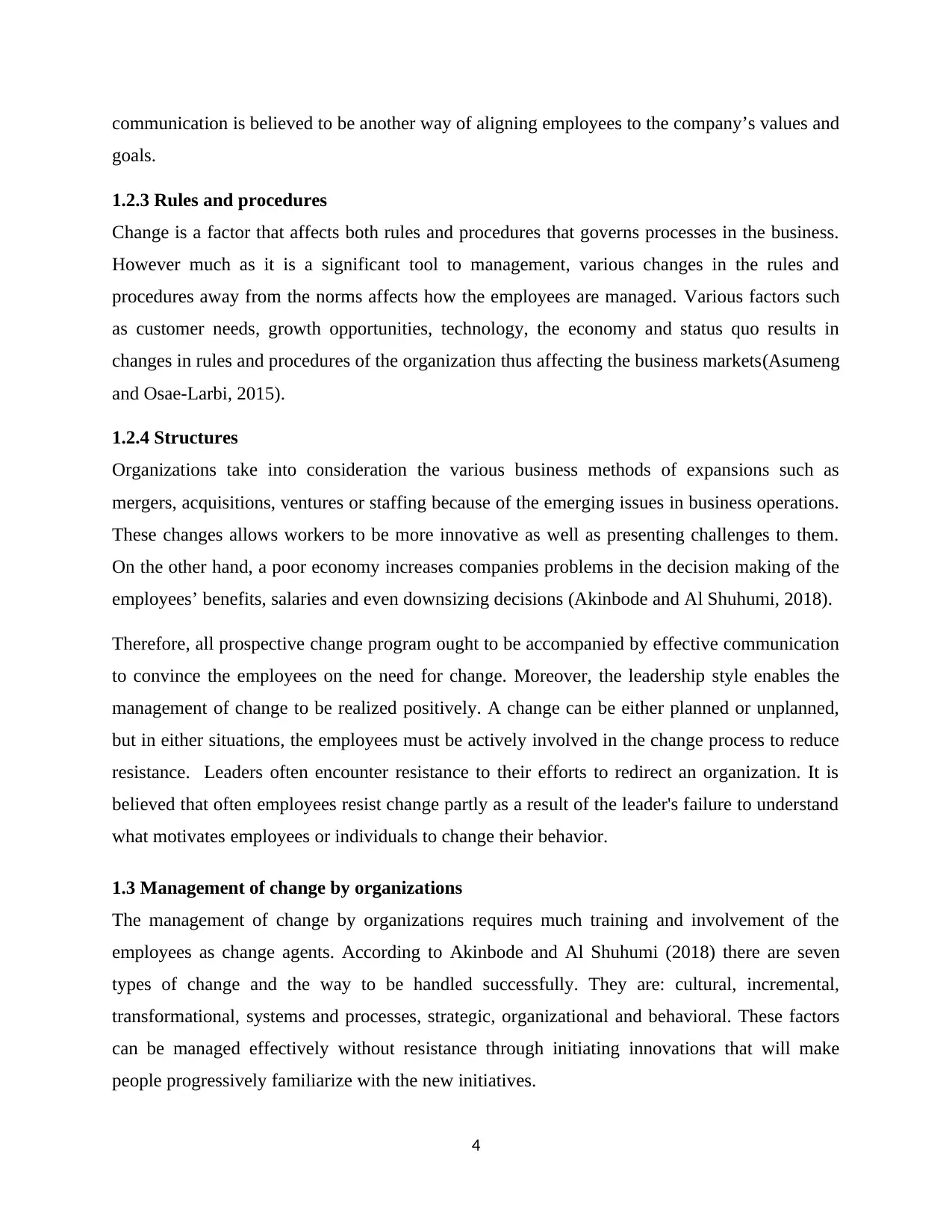
communication is believed to be another way of aligning employees to the company’s values and
goals.
1.2.3 Rules and procedures
Change is a factor that affects both rules and procedures that governs processes in the business.
However much as it is a significant tool to management, various changes in the rules and
procedures away from the norms affects how the employees are managed. Various factors such
as customer needs, growth opportunities, technology, the economy and status quo results in
changes in rules and procedures of the organization thus affecting the business markets(Asumeng
and Osae-Larbi, 2015).
1.2.4 Structures
Organizations take into consideration the various business methods of expansions such as
mergers, acquisitions, ventures or staffing because of the emerging issues in business operations.
These changes allows workers to be more innovative as well as presenting challenges to them.
On the other hand, a poor economy increases companies problems in the decision making of the
employees’ benefits, salaries and even downsizing decisions (Akinbode and Al Shuhumi, 2018).
Therefore, all prospective change program ought to be accompanied by effective communication
to convince the employees on the need for change. Moreover, the leadership style enables the
management of change to be realized positively. A change can be either planned or unplanned,
but in either situations, the employees must be actively involved in the change process to reduce
resistance. Leaders often encounter resistance to their efforts to redirect an organization. It is
believed that often employees resist change partly as a result of the leader's failure to understand
what motivates employees or individuals to change their behavior.
1.3 Management of change by organizations
The management of change by organizations requires much training and involvement of the
employees as change agents. According to Akinbode and Al Shuhumi (2018) there are seven
types of change and the way to be handled successfully. They are: cultural, incremental,
transformational, systems and processes, strategic, organizational and behavioral. These factors
can be managed effectively without resistance through initiating innovations that will make
people progressively familiarize with the new initiatives.
4
goals.
1.2.3 Rules and procedures
Change is a factor that affects both rules and procedures that governs processes in the business.
However much as it is a significant tool to management, various changes in the rules and
procedures away from the norms affects how the employees are managed. Various factors such
as customer needs, growth opportunities, technology, the economy and status quo results in
changes in rules and procedures of the organization thus affecting the business markets(Asumeng
and Osae-Larbi, 2015).
1.2.4 Structures
Organizations take into consideration the various business methods of expansions such as
mergers, acquisitions, ventures or staffing because of the emerging issues in business operations.
These changes allows workers to be more innovative as well as presenting challenges to them.
On the other hand, a poor economy increases companies problems in the decision making of the
employees’ benefits, salaries and even downsizing decisions (Akinbode and Al Shuhumi, 2018).
Therefore, all prospective change program ought to be accompanied by effective communication
to convince the employees on the need for change. Moreover, the leadership style enables the
management of change to be realized positively. A change can be either planned or unplanned,
but in either situations, the employees must be actively involved in the change process to reduce
resistance. Leaders often encounter resistance to their efforts to redirect an organization. It is
believed that often employees resist change partly as a result of the leader's failure to understand
what motivates employees or individuals to change their behavior.
1.3 Management of change by organizations
The management of change by organizations requires much training and involvement of the
employees as change agents. According to Akinbode and Al Shuhumi (2018) there are seven
types of change and the way to be handled successfully. They are: cultural, incremental,
transformational, systems and processes, strategic, organizational and behavioral. These factors
can be managed effectively without resistance through initiating innovations that will make
people progressively familiarize with the new initiatives.
4
Paraphrase This Document
Need a fresh take? Get an instant paraphrase of this document with our AI Paraphraser
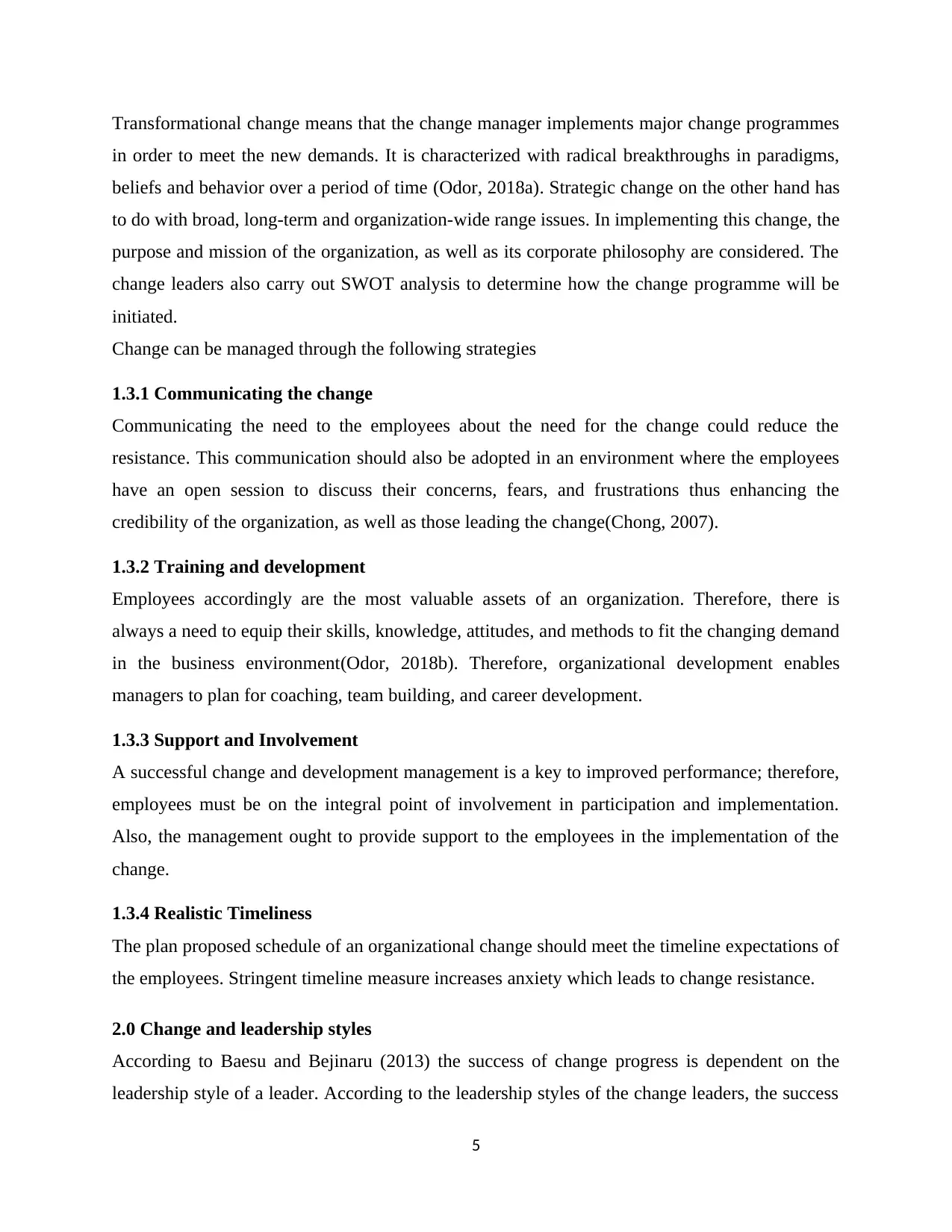
Transformational change means that the change manager implements major change programmes
in order to meet the new demands. It is characterized with radical breakthroughs in paradigms,
beliefs and behavior over a period of time (Odor, 2018a). Strategic change on the other hand has
to do with broad, long-term and organization-wide range issues. In implementing this change, the
purpose and mission of the organization, as well as its corporate philosophy are considered. The
change leaders also carry out SWOT analysis to determine how the change programme will be
initiated.
Change can be managed through the following strategies
1.3.1 Communicating the change
Communicating the need to the employees about the need for the change could reduce the
resistance. This communication should also be adopted in an environment where the employees
have an open session to discuss their concerns, fears, and frustrations thus enhancing the
credibility of the organization, as well as those leading the change(Chong, 2007).
1.3.2 Training and development
Employees accordingly are the most valuable assets of an organization. Therefore, there is
always a need to equip their skills, knowledge, attitudes, and methods to fit the changing demand
in the business environment(Odor, 2018b). Therefore, organizational development enables
managers to plan for coaching, team building, and career development.
1.3.3 Support and Involvement
A successful change and development management is a key to improved performance; therefore,
employees must be on the integral point of involvement in participation and implementation.
Also, the management ought to provide support to the employees in the implementation of the
change.
1.3.4 Realistic Timeliness
The plan proposed schedule of an organizational change should meet the timeline expectations of
the employees. Stringent timeline measure increases anxiety which leads to change resistance.
2.0 Change and leadership styles
According to Baesu and Bejinaru (2013) the success of change progress is dependent on the
leadership style of a leader. According to the leadership styles of the change leaders, the success
5
in order to meet the new demands. It is characterized with radical breakthroughs in paradigms,
beliefs and behavior over a period of time (Odor, 2018a). Strategic change on the other hand has
to do with broad, long-term and organization-wide range issues. In implementing this change, the
purpose and mission of the organization, as well as its corporate philosophy are considered. The
change leaders also carry out SWOT analysis to determine how the change programme will be
initiated.
Change can be managed through the following strategies
1.3.1 Communicating the change
Communicating the need to the employees about the need for the change could reduce the
resistance. This communication should also be adopted in an environment where the employees
have an open session to discuss their concerns, fears, and frustrations thus enhancing the
credibility of the organization, as well as those leading the change(Chong, 2007).
1.3.2 Training and development
Employees accordingly are the most valuable assets of an organization. Therefore, there is
always a need to equip their skills, knowledge, attitudes, and methods to fit the changing demand
in the business environment(Odor, 2018b). Therefore, organizational development enables
managers to plan for coaching, team building, and career development.
1.3.3 Support and Involvement
A successful change and development management is a key to improved performance; therefore,
employees must be on the integral point of involvement in participation and implementation.
Also, the management ought to provide support to the employees in the implementation of the
change.
1.3.4 Realistic Timeliness
The plan proposed schedule of an organizational change should meet the timeline expectations of
the employees. Stringent timeline measure increases anxiety which leads to change resistance.
2.0 Change and leadership styles
According to Baesu and Bejinaru (2013) the success of change progress is dependent on the
leadership style of a leader. According to the leadership styles of the change leaders, the success
5
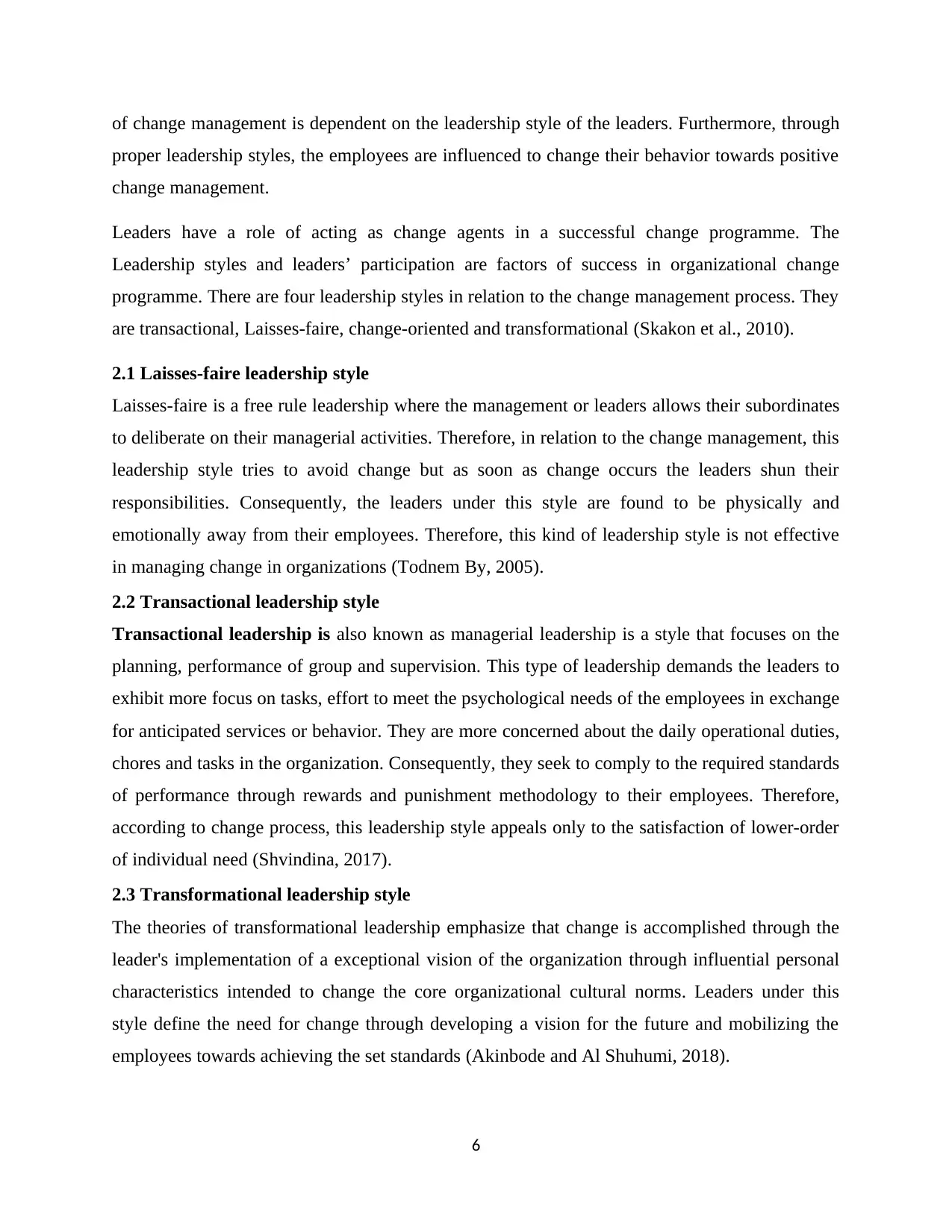
of change management is dependent on the leadership style of the leaders. Furthermore, through
proper leadership styles, the employees are influenced to change their behavior towards positive
change management.
Leaders have a role of acting as change agents in a successful change programme. The
Leadership styles and leaders’ participation are factors of success in organizational change
programme. There are four leadership styles in relation to the change management process. They
are transactional, Laisses-faire, change-oriented and transformational (Skakon et al., 2010).
2.1 Laisses-faire leadership style
Laisses-faire is a free rule leadership where the management or leaders allows their subordinates
to deliberate on their managerial activities. Therefore, in relation to the change management, this
leadership style tries to avoid change but as soon as change occurs the leaders shun their
responsibilities. Consequently, the leaders under this style are found to be physically and
emotionally away from their employees. Therefore, this kind of leadership style is not effective
in managing change in organizations (Todnem By, 2005).
2.2 Transactional leadership style
Transactional leadership is also known as managerial leadership is a style that focuses on the
planning, performance of group and supervision. This type of leadership demands the leaders to
exhibit more focus on tasks, effort to meet the psychological needs of the employees in exchange
for anticipated services or behavior. They are more concerned about the daily operational duties,
chores and tasks in the organization. Consequently, they seek to comply to the required standards
of performance through rewards and punishment methodology to their employees. Therefore,
according to change process, this leadership style appeals only to the satisfaction of lower-order
of individual need (Shvindina, 2017).
2.3 Transformational leadership style
The theories of transformational leadership emphasize that change is accomplished through the
leader's implementation of a exceptional vision of the organization through influential personal
characteristics intended to change the core organizational cultural norms. Leaders under this
style define the need for change through developing a vision for the future and mobilizing the
employees towards achieving the set standards (Akinbode and Al Shuhumi, 2018).
6
proper leadership styles, the employees are influenced to change their behavior towards positive
change management.
Leaders have a role of acting as change agents in a successful change programme. The
Leadership styles and leaders’ participation are factors of success in organizational change
programme. There are four leadership styles in relation to the change management process. They
are transactional, Laisses-faire, change-oriented and transformational (Skakon et al., 2010).
2.1 Laisses-faire leadership style
Laisses-faire is a free rule leadership where the management or leaders allows their subordinates
to deliberate on their managerial activities. Therefore, in relation to the change management, this
leadership style tries to avoid change but as soon as change occurs the leaders shun their
responsibilities. Consequently, the leaders under this style are found to be physically and
emotionally away from their employees. Therefore, this kind of leadership style is not effective
in managing change in organizations (Todnem By, 2005).
2.2 Transactional leadership style
Transactional leadership is also known as managerial leadership is a style that focuses on the
planning, performance of group and supervision. This type of leadership demands the leaders to
exhibit more focus on tasks, effort to meet the psychological needs of the employees in exchange
for anticipated services or behavior. They are more concerned about the daily operational duties,
chores and tasks in the organization. Consequently, they seek to comply to the required standards
of performance through rewards and punishment methodology to their employees. Therefore,
according to change process, this leadership style appeals only to the satisfaction of lower-order
of individual need (Shvindina, 2017).
2.3 Transformational leadership style
The theories of transformational leadership emphasize that change is accomplished through the
leader's implementation of a exceptional vision of the organization through influential personal
characteristics intended to change the core organizational cultural norms. Leaders under this
style define the need for change through developing a vision for the future and mobilizing the
employees towards achieving the set standards (Akinbode and Al Shuhumi, 2018).
6
⊘ This is a preview!⊘
Do you want full access?
Subscribe today to unlock all pages.

Trusted by 1+ million students worldwide
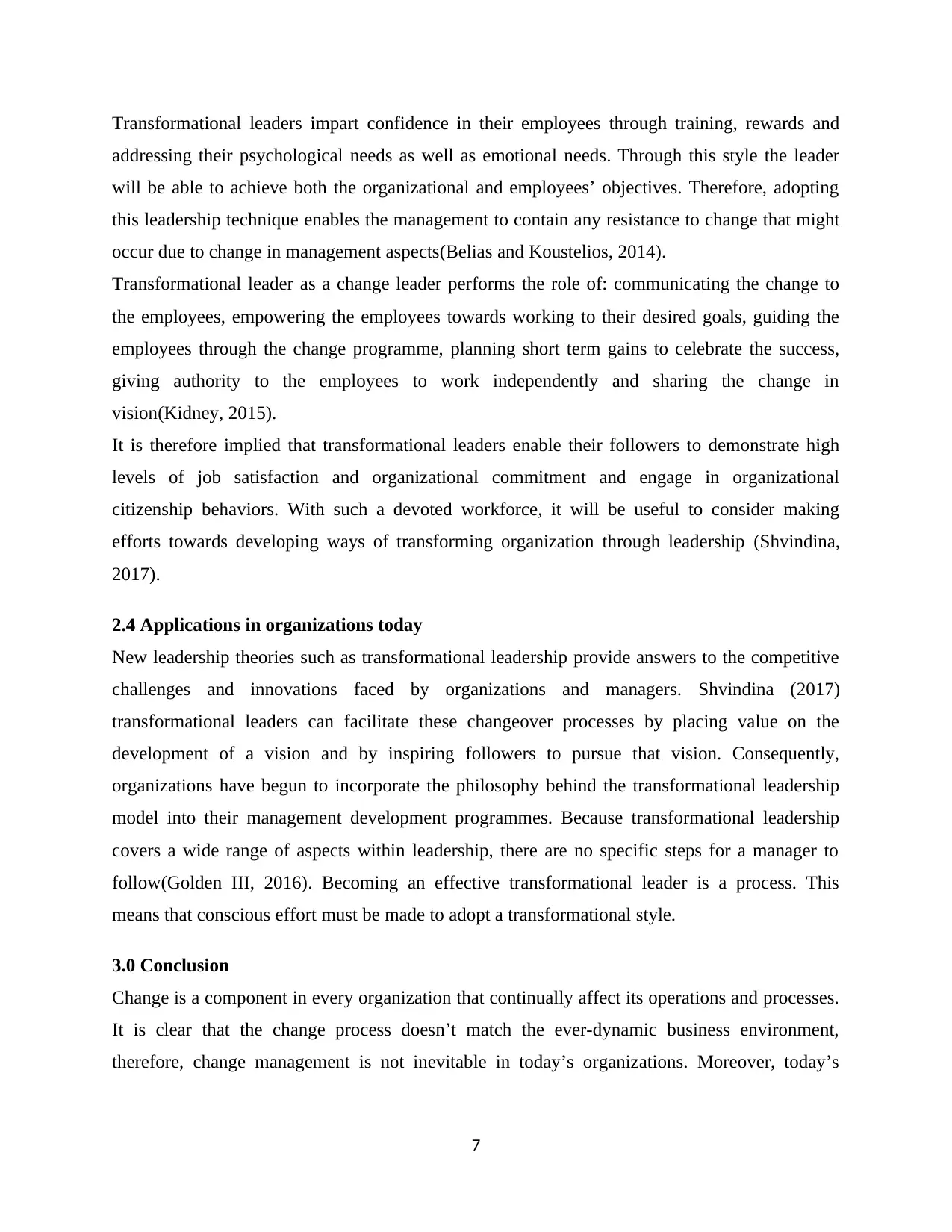
Transformational leaders impart confidence in their employees through training, rewards and
addressing their psychological needs as well as emotional needs. Through this style the leader
will be able to achieve both the organizational and employees’ objectives. Therefore, adopting
this leadership technique enables the management to contain any resistance to change that might
occur due to change in management aspects(Belias and Koustelios, 2014).
Transformational leader as a change leader performs the role of: communicating the change to
the employees, empowering the employees towards working to their desired goals, guiding the
employees through the change programme, planning short term gains to celebrate the success,
giving authority to the employees to work independently and sharing the change in
vision(Kidney, 2015).
It is therefore implied that transformational leaders enable their followers to demonstrate high
levels of job satisfaction and organizational commitment and engage in organizational
citizenship behaviors. With such a devoted workforce, it will be useful to consider making
efforts towards developing ways of transforming organization through leadership (Shvindina,
2017).
2.4 Applications in organizations today
New leadership theories such as transformational leadership provide answers to the competitive
challenges and innovations faced by organizations and managers. Shvindina (2017)
transformational leaders can facilitate these changeover processes by placing value on the
development of a vision and by inspiring followers to pursue that vision. Consequently,
organizations have begun to incorporate the philosophy behind the transformational leadership
model into their management development programmes. Because transformational leadership
covers a wide range of aspects within leadership, there are no specific steps for a manager to
follow(Golden III, 2016). Becoming an effective transformational leader is a process. This
means that conscious effort must be made to adopt a transformational style.
3.0 Conclusion
Change is a component in every organization that continually affect its operations and processes.
It is clear that the change process doesn’t match the ever-dynamic business environment,
therefore, change management is not inevitable in today’s organizations. Moreover, today’s
7
addressing their psychological needs as well as emotional needs. Through this style the leader
will be able to achieve both the organizational and employees’ objectives. Therefore, adopting
this leadership technique enables the management to contain any resistance to change that might
occur due to change in management aspects(Belias and Koustelios, 2014).
Transformational leader as a change leader performs the role of: communicating the change to
the employees, empowering the employees towards working to their desired goals, guiding the
employees through the change programme, planning short term gains to celebrate the success,
giving authority to the employees to work independently and sharing the change in
vision(Kidney, 2015).
It is therefore implied that transformational leaders enable their followers to demonstrate high
levels of job satisfaction and organizational commitment and engage in organizational
citizenship behaviors. With such a devoted workforce, it will be useful to consider making
efforts towards developing ways of transforming organization through leadership (Shvindina,
2017).
2.4 Applications in organizations today
New leadership theories such as transformational leadership provide answers to the competitive
challenges and innovations faced by organizations and managers. Shvindina (2017)
transformational leaders can facilitate these changeover processes by placing value on the
development of a vision and by inspiring followers to pursue that vision. Consequently,
organizations have begun to incorporate the philosophy behind the transformational leadership
model into their management development programmes. Because transformational leadership
covers a wide range of aspects within leadership, there are no specific steps for a manager to
follow(Golden III, 2016). Becoming an effective transformational leader is a process. This
means that conscious effort must be made to adopt a transformational style.
3.0 Conclusion
Change is a component in every organization that continually affect its operations and processes.
It is clear that the change process doesn’t match the ever-dynamic business environment,
therefore, change management is not inevitable in today’s organizations. Moreover, today’s
7
Paraphrase This Document
Need a fresh take? Get an instant paraphrase of this document with our AI Paraphraser
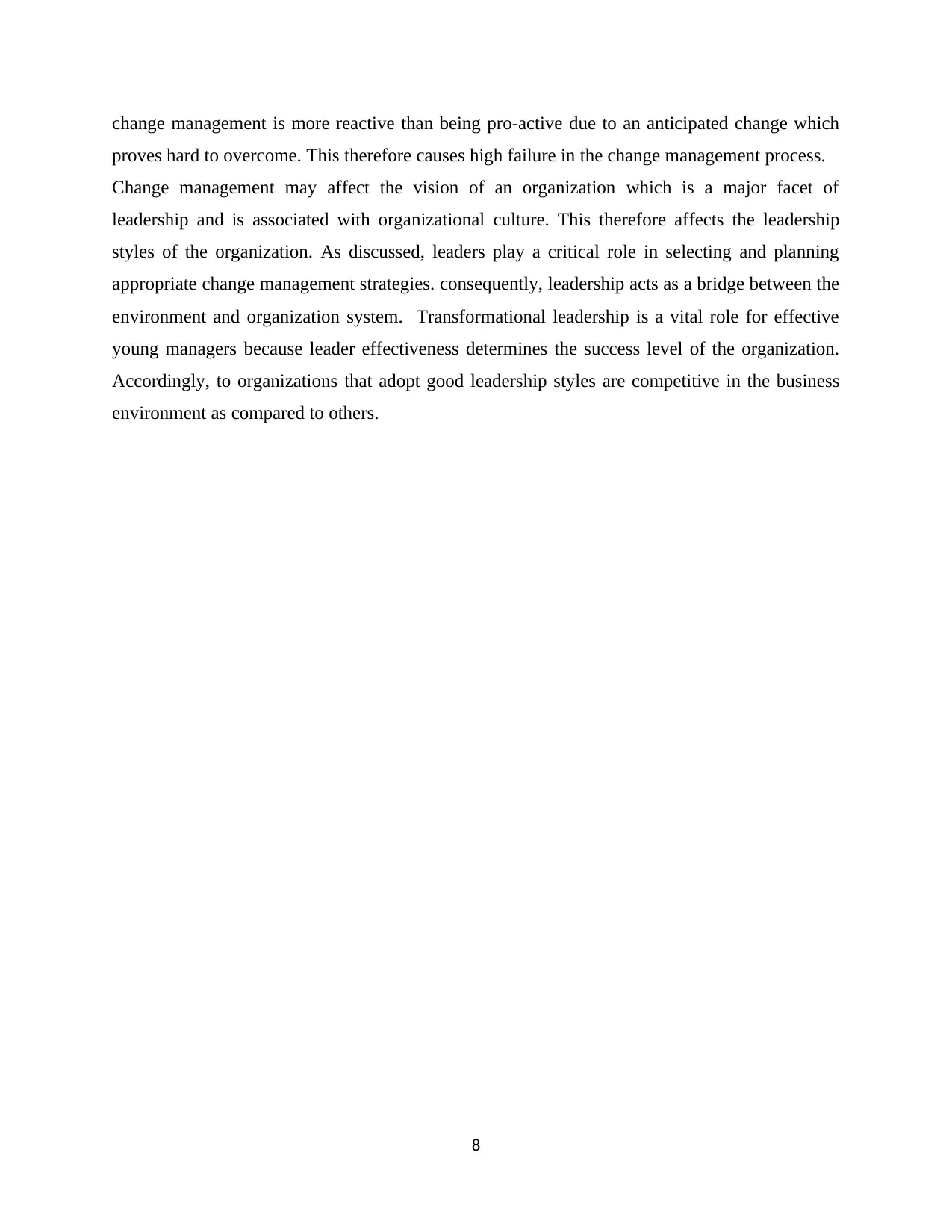
change management is more reactive than being pro-active due to an anticipated change which
proves hard to overcome. This therefore causes high failure in the change management process.
Change management may affect the vision of an organization which is a major facet of
leadership and is associated with organizational culture. This therefore affects the leadership
styles of the organization. As discussed, leaders play a critical role in selecting and planning
appropriate change management strategies. consequently, leadership acts as a bridge between the
environment and organization system. Transformational leadership is a vital role for effective
young managers because leader effectiveness determines the success level of the organization.
Accordingly, to organizations that adopt good leadership styles are competitive in the business
environment as compared to others.
8
proves hard to overcome. This therefore causes high failure in the change management process.
Change management may affect the vision of an organization which is a major facet of
leadership and is associated with organizational culture. This therefore affects the leadership
styles of the organization. As discussed, leaders play a critical role in selecting and planning
appropriate change management strategies. consequently, leadership acts as a bridge between the
environment and organization system. Transformational leadership is a vital role for effective
young managers because leader effectiveness determines the success level of the organization.
Accordingly, to organizations that adopt good leadership styles are competitive in the business
environment as compared to others.
8
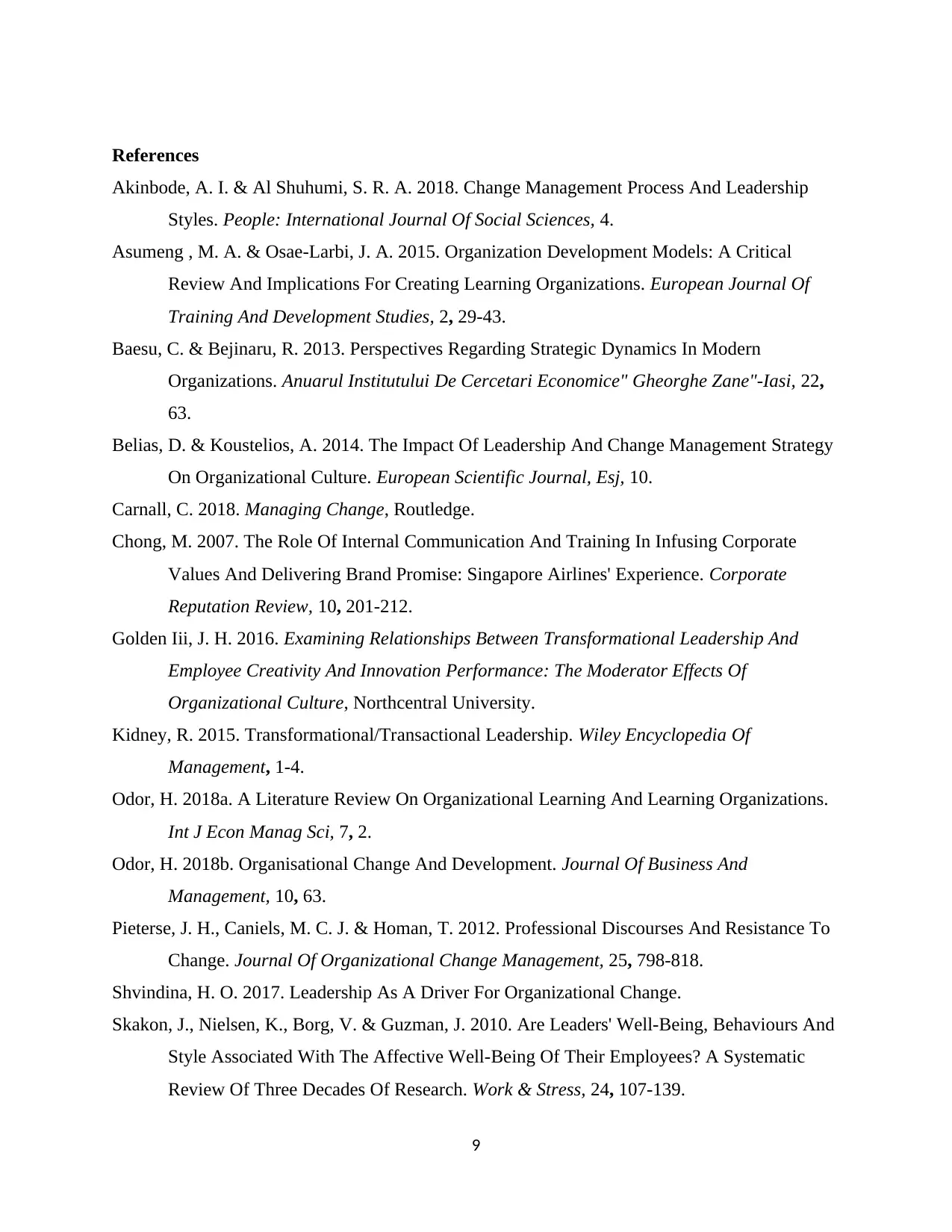
References
Akinbode, A. I. & Al Shuhumi, S. R. A. 2018. Change Management Process And Leadership
Styles. People: International Journal Of Social Sciences, 4.
Asumeng , M. A. & Osae-Larbi, J. A. 2015. Organization Development Models: A Critical
Review And Implications For Creating Learning Organizations. European Journal Of
Training And Development Studies, 2, 29-43.
Baesu, C. & Bejinaru, R. 2013. Perspectives Regarding Strategic Dynamics In Modern
Organizations. Anuarul Institutului De Cercetari Economice" Gheorghe Zane"-Iasi, 22,
63.
Belias, D. & Koustelios, A. 2014. The Impact Of Leadership And Change Management Strategy
On Organizational Culture. European Scientific Journal, Esj, 10.
Carnall, C. 2018. Managing Change, Routledge.
Chong, M. 2007. The Role Of Internal Communication And Training In Infusing Corporate
Values And Delivering Brand Promise: Singapore Airlines' Experience. Corporate
Reputation Review, 10, 201-212.
Golden Iii, J. H. 2016. Examining Relationships Between Transformational Leadership And
Employee Creativity And Innovation Performance: The Moderator Effects Of
Organizational Culture, Northcentral University.
Kidney, R. 2015. Transformational/Transactional Leadership. Wiley Encyclopedia Of
Management, 1-4.
Odor, H. 2018a. A Literature Review On Organizational Learning And Learning Organizations.
Int J Econ Manag Sci, 7, 2.
Odor, H. 2018b. Organisational Change And Development. Journal Of Business And
Management, 10, 63.
Pieterse, J. H., Caniels, M. C. J. & Homan, T. 2012. Professional Discourses And Resistance To
Change. Journal Of Organizational Change Management, 25, 798-818.
Shvindina, H. O. 2017. Leadership As A Driver For Organizational Change.
Skakon, J., Nielsen, K., Borg, V. & Guzman, J. 2010. Are Leaders' Well-Being, Behaviours And
Style Associated With The Affective Well-Being Of Their Employees? A Systematic
Review Of Three Decades Of Research. Work & Stress, 24, 107-139.
9
Akinbode, A. I. & Al Shuhumi, S. R. A. 2018. Change Management Process And Leadership
Styles. People: International Journal Of Social Sciences, 4.
Asumeng , M. A. & Osae-Larbi, J. A. 2015. Organization Development Models: A Critical
Review And Implications For Creating Learning Organizations. European Journal Of
Training And Development Studies, 2, 29-43.
Baesu, C. & Bejinaru, R. 2013. Perspectives Regarding Strategic Dynamics In Modern
Organizations. Anuarul Institutului De Cercetari Economice" Gheorghe Zane"-Iasi, 22,
63.
Belias, D. & Koustelios, A. 2014. The Impact Of Leadership And Change Management Strategy
On Organizational Culture. European Scientific Journal, Esj, 10.
Carnall, C. 2018. Managing Change, Routledge.
Chong, M. 2007. The Role Of Internal Communication And Training In Infusing Corporate
Values And Delivering Brand Promise: Singapore Airlines' Experience. Corporate
Reputation Review, 10, 201-212.
Golden Iii, J. H. 2016. Examining Relationships Between Transformational Leadership And
Employee Creativity And Innovation Performance: The Moderator Effects Of
Organizational Culture, Northcentral University.
Kidney, R. 2015. Transformational/Transactional Leadership. Wiley Encyclopedia Of
Management, 1-4.
Odor, H. 2018a. A Literature Review On Organizational Learning And Learning Organizations.
Int J Econ Manag Sci, 7, 2.
Odor, H. 2018b. Organisational Change And Development. Journal Of Business And
Management, 10, 63.
Pieterse, J. H., Caniels, M. C. J. & Homan, T. 2012. Professional Discourses And Resistance To
Change. Journal Of Organizational Change Management, 25, 798-818.
Shvindina, H. O. 2017. Leadership As A Driver For Organizational Change.
Skakon, J., Nielsen, K., Borg, V. & Guzman, J. 2010. Are Leaders' Well-Being, Behaviours And
Style Associated With The Affective Well-Being Of Their Employees? A Systematic
Review Of Three Decades Of Research. Work & Stress, 24, 107-139.
9
⊘ This is a preview!⊘
Do you want full access?
Subscribe today to unlock all pages.

Trusted by 1+ million students worldwide
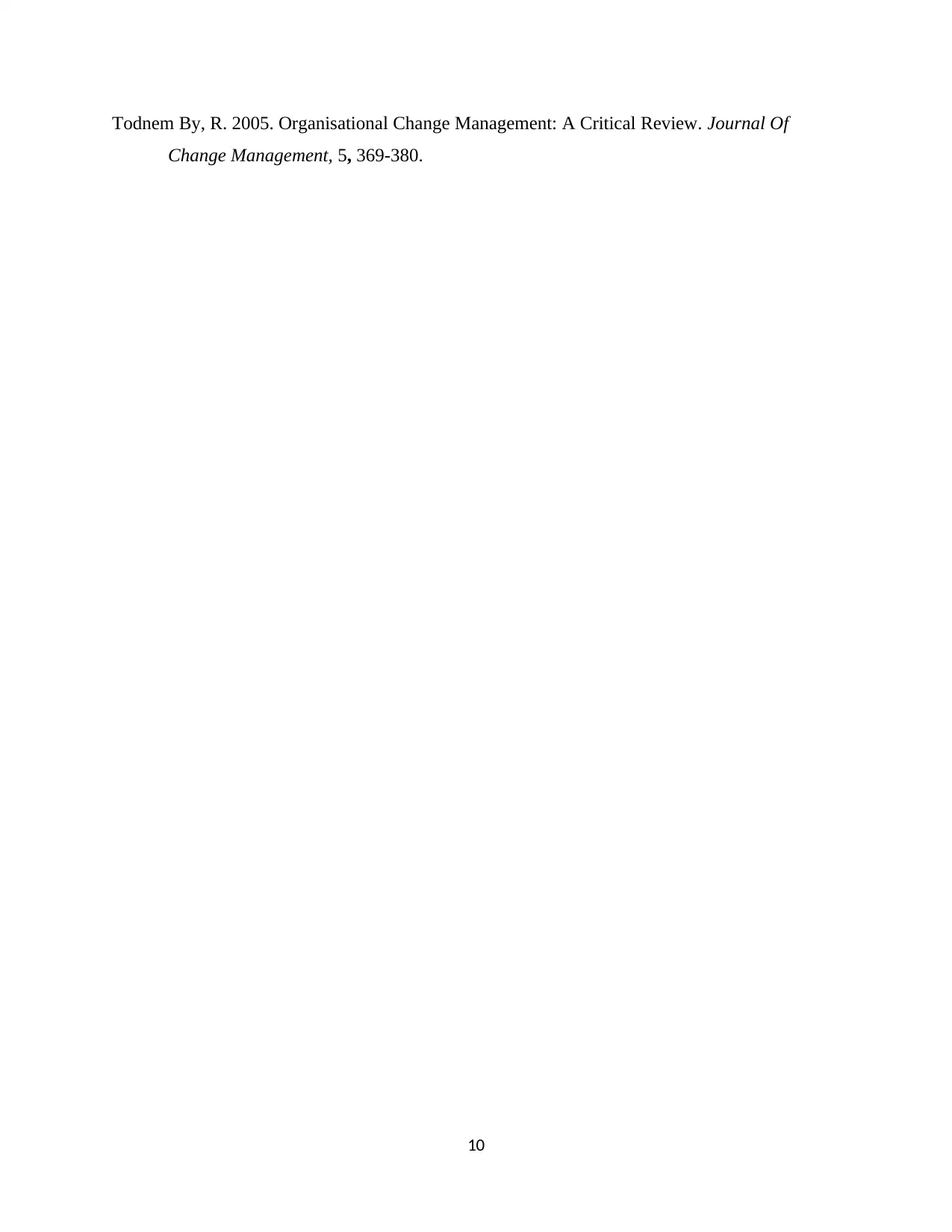
Todnem By, R. 2005. Organisational Change Management: A Critical Review. Journal Of
Change Management, 5, 369-380.
10
Change Management, 5, 369-380.
10
1 out of 10
Related Documents
Your All-in-One AI-Powered Toolkit for Academic Success.
+13062052269
info@desklib.com
Available 24*7 on WhatsApp / Email
![[object Object]](/_next/static/media/star-bottom.7253800d.svg)
Unlock your academic potential
Copyright © 2020–2025 A2Z Services. All Rights Reserved. Developed and managed by ZUCOL.





